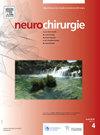鼻内窥镜手术入路治疗三叉神经鞘瘤:系统回顾和荟萃分析
IF 1.4
4区 医学
Q4 CLINICAL NEUROLOGY
引用次数: 0
摘要
三叉神经鞘瘤(TSs)是第二常见的颅内神经鞘瘤。手术入路的选择取决于肿瘤扩散的类型。中窝硬膜外入路、颞下硬膜外入路、经上颌入路、经下颌入路和经颈椎入路已被采用。然而,这些入路有多种并发症,包括其他脑神经功能障碍。近年来,随着内窥镜技术的广泛应用,内窥镜鼻内入路(EEA)似乎成为治疗颅底病理的另一种颅底手术入路。目的评价EEA方法治疗TSs的安全性和有效性。方法按照PRISMA指南检索Medline、Embase和Web of Science数据库。我们采用随机效应模型下95%置信区间(CI)的单比例分析(I2)来评估异质性,采用Baujat和敏感性分析来解决高异质性。符合条件的研究包括≥4例经鼻内窥镜入路治疗三叉神经鞘瘤的患者。在最初确定的2550项研究中,选择了9项,涉及195名患者,中位随访时间为36个月。综合分析显示部分切除率为29% (CI: 11%-49%),而综合分析显示完全切除率为84% (CI: 68%-99%)。颅神经保存率达99% (CI: 96%-100%),面部功能保存率为100% (CI: 97%-100%),并发症发生率为5% (CI: 0%-13%)。基于这些发现,我们的meta分析发现鼻内窥镜入路治疗三叉神经鞘瘤的并发症发生率低,在保留面部功能和脑神经方面效果良好,并且完全切除的结果表明其有效率高。本文章由计算机程序翻译,如有差异,请以英文原文为准。
Endonasal endoscopic surgical approach for treating trigeminal schwannomas: A systematic review and meta-analysis
Introduction
Trigeminal schwannomas (TSs) are the second most common type of intracranial schwannoma. Surgical approaches are chosen depending on the type of tumor extension. The middle fossa extradural approach, infratemporal extradural approach, transmaxillary approach, transmandibular approach, and transcervical approach have been used. However, these approaches are associated with a variety of complications including other cranial nerve dysfunction. Recently, with the wide application of endoscopic technology, the endoscopic endonasal approach (EEA) seems to be an alternative skull base surgical approach for skull base pathology.
Objective
The objective of the present study is to evaluate the safety and efficacy EEA approach for TSs.
Methods
We searched Medline, Embase, and Web of Science databases following PRISMA guidelines. We used single proportion analysis with 95% confidence intervals (CI) under a random-effects model, I2 to assess heterogeneity, and Baujat and sensitivity analysis to address high heterogeneity. Eligible studies included those with ≥4 patients treated with the endoscopic endonasal approach for trigeminal schwannomas.
Results
Of the 2550 initially identified studies, 9 were selected, involving 195 patients, with a median follow-up of 36 months. The combined analysis showed a 29% (CI: 11%–49%) partial resection rate, while a pooled analysis for complete resection demonstrated an 84% rate (CI: 68%–99%). Preservation of cranial nerves reached a 99% rate (CI: 96%–100%) with a 100% preservation of facial function rate (CI: 97%–100%) and a 5% complications rate (CI: 0%–13%).
Conclusion
Based on these findings, our meta-analysis identified that the endonasal endoscopic approach for the treatment of trigeminal schwannomas presents a low rate of complications, favorable results regarding the preservation of facial function and cranial nerves, and, a high rate of effectiveness, demonstrated by the results of complete resection.
求助全文
通过发布文献求助,成功后即可免费获取论文全文。
去求助
来源期刊

Neurochirurgie
医学-临床神经学
CiteScore
2.70
自引率
6.20%
发文量
100
审稿时长
29 days
期刊介绍:
Neurochirurgie publishes articles on treatment, teaching and research, neurosurgery training and the professional aspects of our discipline, and also the history and progress of neurosurgery. It focuses on pathologies of the head, spine and central and peripheral nervous systems and their vascularization. All aspects of the specialty are dealt with: trauma, tumor, degenerative disease, infection, vascular pathology, and radiosurgery, and pediatrics. Transversal studies are also welcome: neuroanatomy, neurophysiology, neurology, neuropediatrics, psychiatry, neuropsychology, physical medicine and neurologic rehabilitation, neuro-anesthesia, neurologic intensive care, neuroradiology, functional exploration, neuropathology, neuro-ophthalmology, otoneurology, maxillofacial surgery, neuro-endocrinology and spine surgery. Technical and methodological aspects are also taken onboard: diagnostic and therapeutic techniques, methods for assessing results, epidemiology, surgical, interventional and radiological techniques, simulations and pathophysiological hypotheses, and educational tools. The editorial board may refuse submissions that fail to meet the journal''s aims and scope; such studies will not be peer-reviewed, and the editor in chief will promptly inform the corresponding author, so as not to delay submission to a more suitable journal.
With a view to attracting an international audience of both readers and writers, Neurochirurgie especially welcomes articles in English, and gives priority to original studies. Other kinds of article - reviews, case reports, technical notes and meta-analyses - are equally published.
Every year, a special edition is dedicated to the topic selected by the French Society of Neurosurgery for its annual report.
 求助内容:
求助内容: 应助结果提醒方式:
应助结果提醒方式:


